Toyota Kata
The Improvement Kata 9
The Coaching Kata 15
Toyota Kata contains two basic patterns of acting and thinking. The first basic pattern is called the Improvement Kata which is intended for everyone. The second basic pattern, called the Coaching Kata, is the corresponding management pattern to train and reinforce the Improvement Kata way of thinking and acting and make it a habit throughout the organization.
 The Improvement Kata
The Improvement Kata
Why practice it?
The Improvement Kata resembles a new way of thinking and acting. In the business world and in daily life we are used to taking quick actions based on assumptions and experience. When pursuing targets we make a plan,
deliberately execute it, and evaluate the effect once completed. This approach has a great advantage: Speed. An experience based action or plan saves us time spent in analysis and reinventing the wheel over and over again. That is why this approach works so well in everyday situations such as driving a car and other repetitive actions, small and large. However, acting on experience and making a plan are based on the same assumption: what was true in the past will be true in the future.
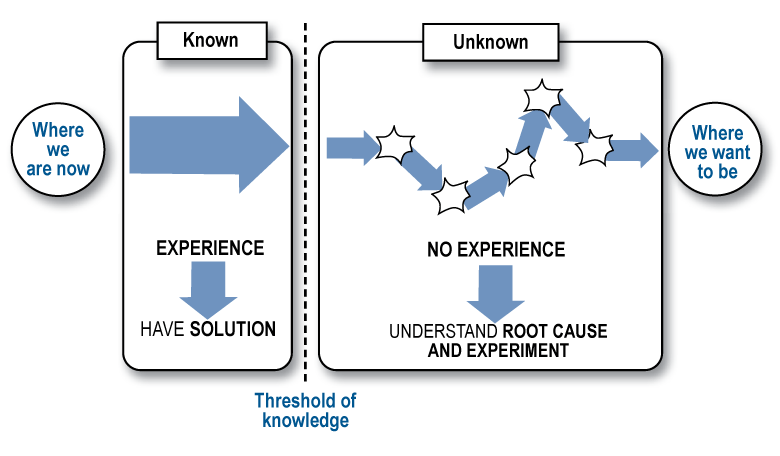
In a constantly changing environment this assumption is becoming more and more unlikely. New problems require new solutions. When faced with new circumstances we have to change our approach. We need to proceed step-by-step and experiment instead of making quick assumptions and experience based planning, decision making, and action. Unfortunately, that is not how our biased brain works and we have been trained throughout our careers to quickly jump to conclusions and execute plans. The Improvement Kata will enable us to step up our game and learn a new, more scientific way of thinking and acting. The person working on the process with the Improvement Kata is called the Improver.
What does it do?
Throughout life our brain builds neural pathways. Every time we repeat an action or thought process corresponding neural pathways are reinforced. This is how we learn and how we become experts in the things we do often. Things we do very often even become habits. Habits are controlled by a special region of the brain which helps us to execute them without cognitive thinking, at great speed and with a low amount of energy.
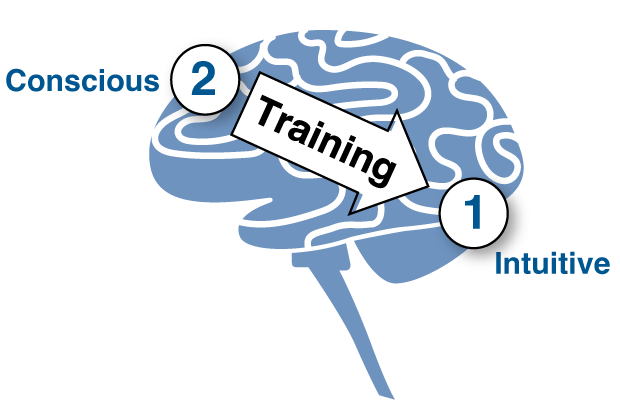
A habit follows a simple code: If A do B. This is why we continue doing what has proved to be successful. Learning a new way of thinking and acting requires cognitive thinking as the brain has to build and follow new neural pathways. This is why learning takes time and energy and even feels painful at times. The construction work in our brain is most effective if we repeatedly practice a pattern. This approach is used in many fields: In sports it is called a training routine, in music it is scales, in cooking it is a recipe, and in martial arts it is called Kata.
A Kata is a training routine to learn a desired way of acting and thinking and make it a new habit.
The Improvement Kata enables us to:
- Learn a way of scientific thinking and acting to reach challenging targets beyond our current know-how and capability.
- Increase self-motivation and the ability to cope with uncertainty and change.
How do I do it?
The Improvement Kata pattern contains four steps that each train underlying mindsets:
1. Understand the Direction or Challenge - Ask yourself: What is the long-term goal we are striving for? This will help to keep you focused along the way. Daily business confronts us with an overwhelming amount of information and requests. Often we try to do everything believing the more the better. We have a great need to learn to focus on the important things. A long-term goal will also give purpose to our efforts and fuel motivation when things get more difficult. Underlying mindset: Always strive for an inspiring challenge.
2. Grasp the Current Condition - Avoiding assumptions starts with getting the facts instead of relying on beliefs, experience, and the opinions of others. Do this first, do it always, and do it firsthand. Go and see. Underlying mindset: Get the facts firsthand.
3. Establish the Next Target Condition - As inspiring as a long-term challenge may be, it can also be demotivating, and keep us from getting started. Slicing the challenge into smaller pieces, called Target Conditions, will help. A question to get started could be: Where do I want to be in four weeks regarding my long-term challenge? Underlying mindset: Break big challenges into smaller parts and strive for one Target Condition at a time.
4. Experiment Toward the Target Condition - In unknown territory no plan survives first contact with reality. To be successful we have to go step-by-step deliberately testing our conclusions by experimenting. This approach of proving — or more often disproving — our hypothesis about how something works will not only help us to get things right but will also lead to a better understanding of cause and effect and thereby generate new solutions. Underlying mindset: Experiment quickly to learn step-by-step.
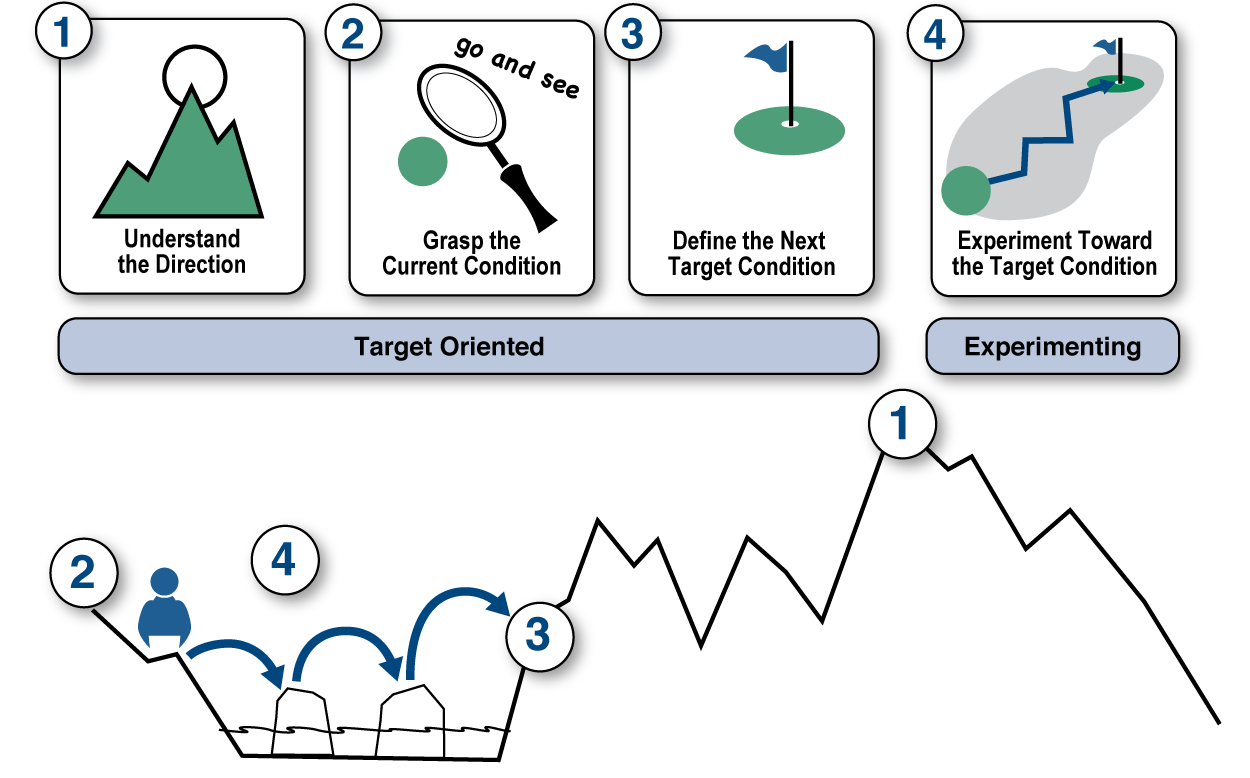
 The Coaching Kata
The Coaching Kata
Why practice it?
The Coaching Kata is a practice routine for the Coach to help reinforce the Improvement Kata in the organization. In sports, professionals have a Coach, amateurs typically do not. If we want to escape our assumptions and brain biases it is important to have a Coach. A Coach will keep us target oriented and help us to work using analysis and experiments. If we want to help a friend, co-worker, or our team to reach challenging goals we might help them most by taking on the role of a Coach. The role of the Coach is to support the individual or the team in getting their priorities right despite the many demands of daily life, helping them to apply the Improvement Kata, and facilitating their self-motivation by refraining from giving advice, knowing things better, and promoting our own ideas. The Coaching Kata helps to train and reinforce the Improvement Kata way of thinking and acting throughout the organization.
What does it do?
The Coaching Kata:
- Sets the priority of improvement and strategic targets.
- Increases people's ability to work scientifically and reach challenging goals.
- Enables self-motivation and increases self-dependency.
- Over time, it creates a habit of improving every day.
How do I do it? 
There are four main steps to the Coaching Kata:
1. Get the mindset right: The task of a Coach is helping people to grow. As parents and teachers we see this clearly. For a friend we might easily role-play being a Coach. As a manager coaching is a lot harder. Why should we do it? A target can only be achieved in a sustainable way by changing and improving the underlying process. If and how well the process is improved will depend on the ability of the people working in and on the process. Organizations therefore will never be better than the ability of their people. Investing in people's ability might be the best investment we can make. Increasing people's ability means focusing on the method rather than on the content. And self-motivation needs self-control — so boss, no solutions please.
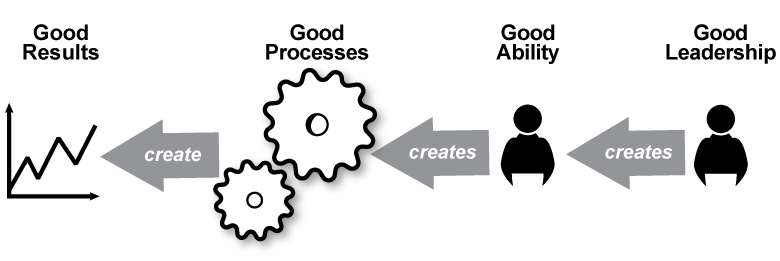
2. Define the roles: Define who will be the Improver and who will be the Coach. The Improver is responsible for improving the process i.e. applying the Improvement Kata to work scientifically towards the defined Target Condition. The Coach is responsible for training and helping the Improver to apply the Improvement Kata precisely.
Although the Coach might by the responsible manager he/she is not, by being in the role of Coach, superior to the Improver. They are in this together. One (the Improver), is focusing on WHAT needs to be done and the other (the Coach), is focused on HOW to approach it systematically.
Remark: In other books the Improver is often also referred to as the Learner. Sometimes this could imply that only the Learner has to learn. In most cases Learner and Coach have to learn and both do learn. The Learner learns how to act and think in a more scientific way and the Coach learns how to coach better. The latter might even be the bigger learning task, especially in a business setting. Therefore, it is more like Improver-Learner and Coach-Learner. Also, a person who takes the role of an Improver for one Target Condition might at the same time be a Coach for somebody else on a different Target Condition. In this Memory Jogger we will therefore use the terms Improver and Coach for the two roles.
Becoming and improving as a Coach is a continuous learning process. Therefore, it is beneficial for the Coach to have a Coach for him/herself. This role is called the Second Coach.
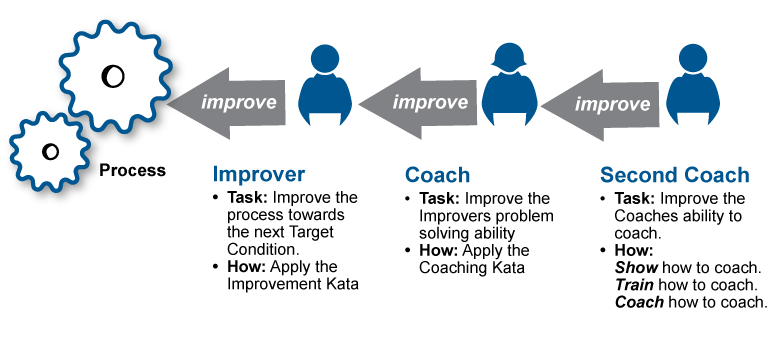
3. Setup the Coaching Cycle: The Coaching Cycle is when the Improver and Coach meet at the Storyboard to discuss learnings from the last step and the Improver's plan for the next step. Ideally you should set up a daily appointment for the Coaching Cycle. Why daily? Because priority beats motivation. Here is an example:
Q: How do we manage in a crisis situation?
A: Insist on a daily status report!
Interpretation: If something is really important my boss will ask for it every day.
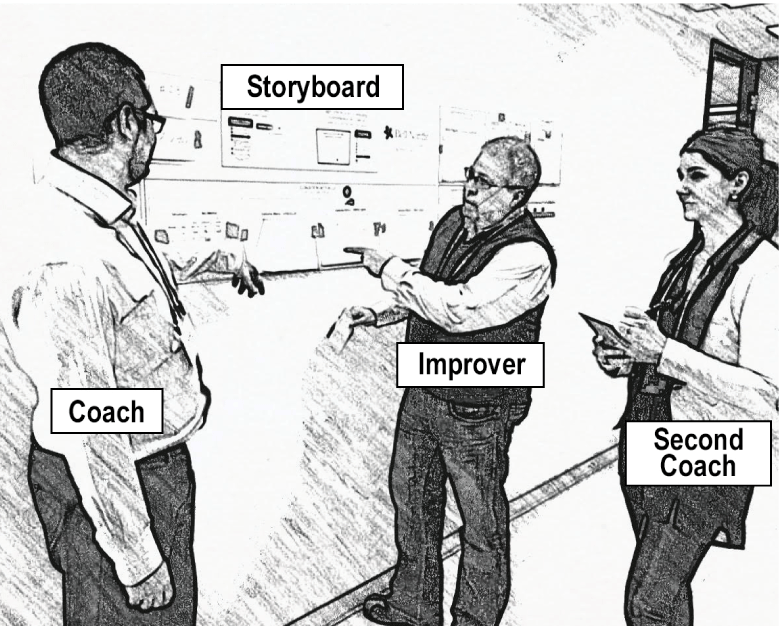
If we want improvement and working on targets to happen every day, then we should ask for it to happen daily. Otherwise the daily business activities will take priority. Therefore, it is good to have a Coaching Cycle every day. Over time an organization even might establish a Coaching Cascade having Coaching Cycles on all levels every day. This will not only ensure priority but also create a new habit, and habits need no motivation. This is when improvement turns into a self-evident part of daily work, everybody, in every process, every day.
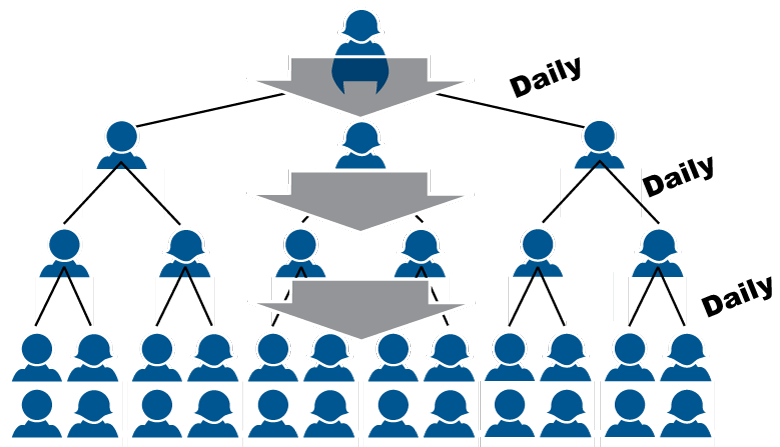
4. Start with the Five Questions of the Coaching Kata: Focusing on the method and staying solution open is the most difficult part for the Coach. How can the Coach do this? By asking open questions and using the Coaching Kata as a starting frame of reference.
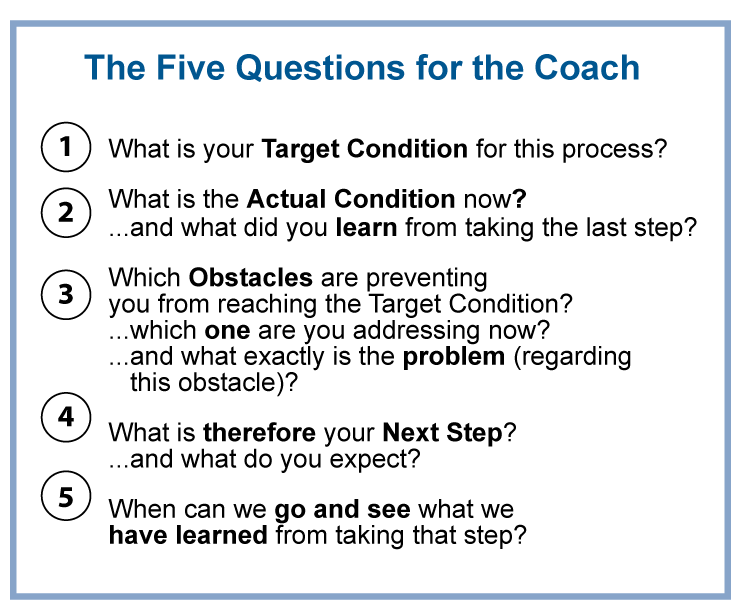
Remark: For readers already familiar with the Coaching Kata you might have realized that the Five Questions of the Coaching Kata mentioned here differ slightly from those in the Toyota Kata Practice Guide and other books, see figure 2.12. The purpose of these adaptations is to make the beginner Coach more effective while at the same time providing an easier start. The two modifications are:
1. Adding the question "What exactly is the problem (regarding this obstacle)?"
2. Moving the question "What did you learn from taking the last step?" to the front of the card and thus eliminating the back side of the card.
Why do we propose these two modifications?
First: With our existing mindset it is easy, once having identified an obstacle, to jump to a quick countermeasure. The question "And what exactly is the problem (regarding this obstacle)?" acts as a safeguard to make sure we understand effect and root cause of an obstacle before we jump to a countermeasure. It also indicates that there is a difference between symptom (obstacle) and cause. This takes the conversation one level deeper.
Second: Coaching is about developing ability and this requires that we first understand current ability. Asking questions that are as open as possible is essential to have the least influence on the Improver's answer. We should also avoid asking the Improver checklist style questions as this will disguise the current state of his/her ability. This is why we propose to first ask "What did you learn from taking the last step?" An experienced Improver will link the answer to his/her last step and the expectation. If the answer is imprecise the Coach might follow up with deepening questions as explained in the Coaching Kata chapter.
Despite these modifications it is important to point out that the Five Questions, as a starting point for the Coach, are not to be experimented with or changed arbitrarily. The modifications we have made are based on the observation of several thousand Coaching Cycles and have been tested in many companies over the last few years. If your team or organization is already using the Toyota Kata Practice Guide version of the five questions, we highly recommend you continue with this as it is an artifact for modifying culture and as such should be perceived as stable. You could advise beginner Coaches who have mastered the questions on the card to use "What exactly is the problem (regarding this obstacle)?" as a first deepening question to be more effective during root cause analysis. You might also invite experienced Coaches to reduce the number of questions regarding the last step to give more room to the Improver to explain in his/her own style and thus understand his/her current ability.
How to use the questions
Developing ability starts with the evaluation of the current ability. Just like a ski coach starts with giving a task and observing rather than giving immediate advice. Then the ski coach compares what he/she observes to a reference in his/her mind, a picture of what should happen. Based on this evaluation the ski coach starts to train. It is a four step process.

In a Coaching Cycle asking an open question and then waiting for the answer to understand how the Improver sees the situation is the equivalent of the Give Task and Observe steps. An experienced Coach will evaluate the answer and react with deepening questions if necessary. (See the Coaching Kata chapter of this Memory Jogger). To do this well, the Coach needs to have a reference, just as a ski coach does.
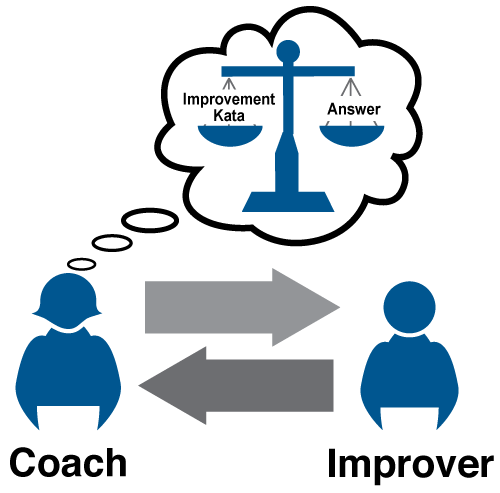
What might serve as such a reference for the Coach? The Improvement Kata Cycle (figure 2.11). Let's now take a closer look at the Improvement Kata Cycle and the scientific approach we follow when using the Improvement Kata.
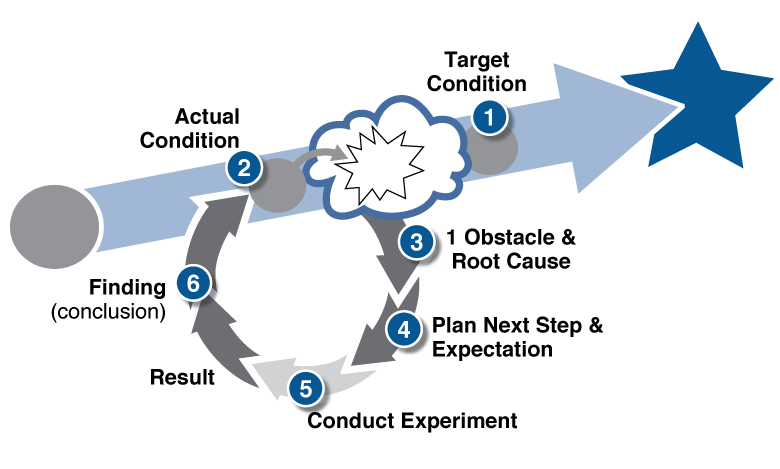
To avoid an assumption based approach and arbitrary actions it is best to follow the Improvement Kata Cycle step-by-step. Note how the five questions match with the corresponding steps of the cycle. They are a helpful support to challenge our logic and stay on track. This is why the five questions are the way they are. The Improvement Kata cycle will prove to be a good reference for the Coach. The Coach can ask him/herself where should we be in the cycle and what kind of answer does the Improver give me. A common pattern for Improvers is to jump from actual condition directly to conducting an immediate but temporary countermeasure.
It is important to remember that coaching is not about the content. Coaching is about the logic of the approach and increasing the knowledge threshold of the Improver. Also, the Coaching Kata is not for the Coach to understand the problem; it is to understand the Improver's current ability and mindset.
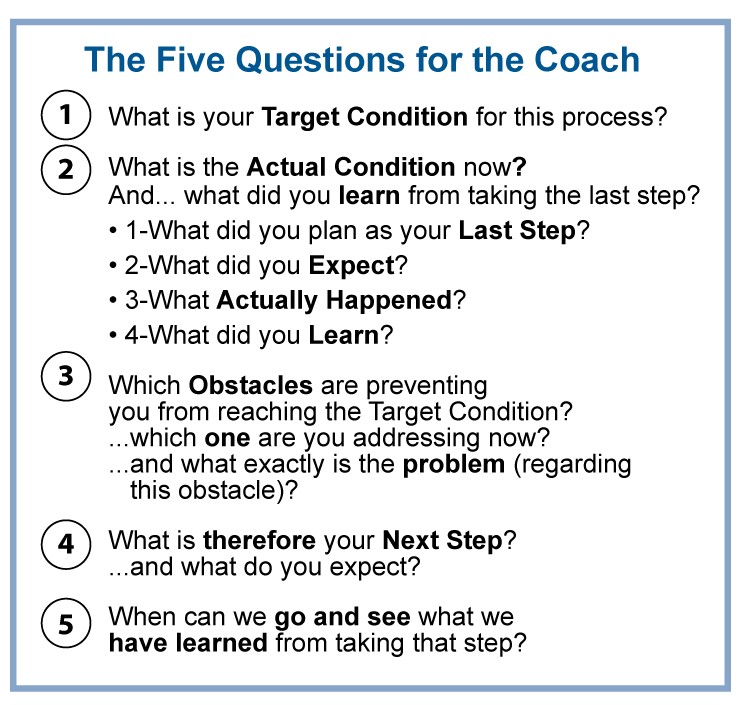
Remark: As you read through this Memory Jogger you will see many graphics used to explain how to implement Toyota Kata. Most of these graphics are available as downloadable PDF templates at the following link:
www.goalqpc.com/product/toyota-kata-downloads/